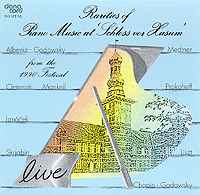 Composer: Beniamino Gigli
Composer: Beniamino Gigli
Works: The complete HMV recordings (1938-1940)
Performers: Beniamino Gigli (tenor), Maria Caniglia (soprano), Cloe Elmo (mezzo-soprano), Giuseppe Noto (baritone), Various orchestras conducted by Dino Oliveri, Lawrance Collingwood, Luigi Ricci, Umberto Berrettoni
Recording: ROMOPHONE 82023-2 [77′ 26″]
Label: Romophone
Beniamino Gigli, a titan of the tenor repertoire, stands as an emblematic figure of early 20th-century opera, captivating audiences with his rich, emotive voice and distinctive interpretative style. The collection of his complete HMV recordings from 1938 to 1940 serves as a testament to his artistry during a critical period that bridged the golden age of operatic singing and the advent of modern recording techniques. This compilation offers a glimpse into a transitional time in the recording industry, capturing not only Gigli’s vocal prowess but also the stylistic conventions of the era, characterized by lush orchestral accompaniments and expressive phrasing.
The performances herein are imbued with Gigli’s trademark warmth and passion, most notably in operatic arias such as “Dalla sua pace” from Don Giovanni and “Di quella pira” from Il Trovatore. His approach to phrasing, marked by an emotive use of portamento, allows for an expressive delivery that, while occasionally veering into the realm of excess, often enhances the inherent drama of the music. The choice to employ scooping—an expressive device where the singer glides to a note—can be polarizing; however, in the context of these recordings, it serves to underscore the heightened emotional landscapes of the arias. Notably, in his renditions of Verdi, particularly “Oh mia Violetta,” Gigli’s interpretation encapsulates both the tragic and the tender, showcasing a nuanced understanding of character that resonates deeply.
Although the operatic selections are the highlights, the inclusion of Italian art songs such as “Amarilli” by Caccini and “O del mio amato ben” by Donaudy allows for a more intimate exploration of Gigli’s vocal capabilities. Here, his ability to convey subtlety and seduction shines through, unencumbered by the larger operatic drama. Yet, his forays into German repertoire, specifically Brahms’ “Wiegenlied” and Schubert’s “Ständchen,” reveal a less polished linguistic command, detracting from the overall impact. Despite this, Gigli’s inherent musicality and sensitivity to the idiomatic nuances of these pieces allow the listener to appreciate the emotional depth he brings, even when linguistic authenticity falters.
The technical quality of the recordings is commendable, particularly given the era. Mark Obert-Thorn’s restoration work breathes life into these historical performances, preserving the warmth and immediacy of the original recordings. The orchestral accompaniments, conducted by a range of notable maestros, are lush yet occasionally overwhelming, leading to moments where the orchestration distracts from Gigli’s voice. However, the balance is generally well-maintained, allowing the tenor’s expressive nuances to shine through.
Comparatively, while many contemporary tenors may present a more polished sound with greater attention to diction and stylistic authenticity, Gigli’s recordings carry an undeniable historical weight. His unique interpretative choices, steeped in the traditions of his time, offer a window into the evolution of tenor singing. The emotive potency found in his performances, particularly in the climactic moments of arias, remains compelling and relevant, inviting listeners to experience the emotional truth of the music.
This collection is not merely a compilation of historical recordings; it is a vibrant encapsulation of a remarkable artist’s ability to transcend the limitations of the medium. Gigli’s expressive range, coupled with his undeniable charisma, ensures that this disc will resonate with both admirers of his legacy and newcomers to his enchanting world. The artistry displayed in these recordings is a compelling reminder of why Gigli remains a towering figure in the pantheon of operatic tenors, deserving of both reverence and renewed exploration.



